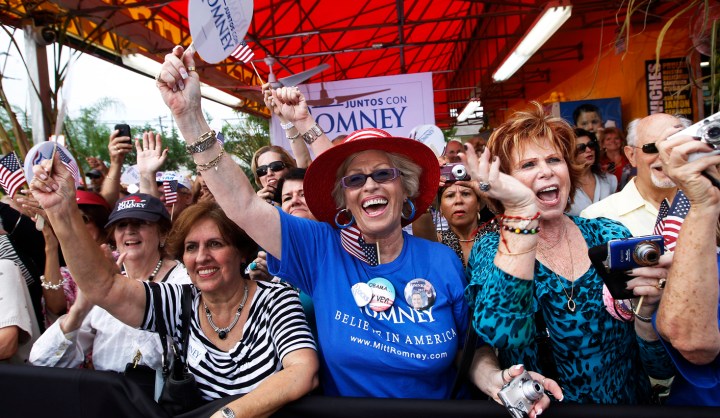World
US 2012: The battleground states – decision-making on steroids

It may well be a national election, but quirks in its electoral system mean the US presidential campaign will be fought out in only a handful of “battleground states”. With a disproportionate share of candidates’ time, money and other resources spent in a few states, is it any way to run a democracy? By J BROOKS SPECTOR.
Today this writer is wandering through Kruger National Park, rather than trawling the Internet for clues about international developments. He is on the prowl for elusive creatures like leopards and black rhino, but is also learning to cope with the jostling, albeit ill-mannered traffic (of the human kind) at the many waterholes and bird watching blinds that Kruger has to offer. Nevertheless, he sends this message through to the editors via one of those legendary forked sticks of Evelyn Waugh fame, in response to numerous queries he has been receiving about the curious mechanics of the American political system—specifically, what battleground states are, and why they seem to matter so much in this year’s presidential election.
But before we even try to tackle the problematic nature of the “battleground state”, perhaps there is also a need for a brief synopsis of the process that will occur from now on. As Daily Maverick readers already know well, incumbent President Barack Obama will be re-nominated at the Democratic National Convention in Charlotte, North Carolina, at the beginning of September. In a very technical sense, he isn’t actually the party’s nominee until that happens.
Meanwhile, the Republican Party’s convention begins a few days earlier, 27 August in Tampa, Florida. At that convention, several candidates will have their names placed in nomination by virtue of having won delegates in the various primaries. But Mitt Romney will be the party’s candidate (unless something truly extraordinary happens in the next two weeks, like a major and mightily embarrassing financial scandal) by virtue of his having won a majority of delegates in the party’s various state primaries.
In the interim, Romney has just announced his choice for his vice presidential running mate, seven-term Wisconsin Congressman Paul Ryan. Ryan is chairman of the House Budget Committee and the author of the controversial Republican budget/tax plan beloved by fiscal conservatives and fundamentally distrusted by most Democrats.
In times past, American presidential campaigns, which are held on the first Tuesday in November, began after the Labour Day. That holiday, the first Monday of September, signals the end of summer, the return to school and the end of those lazy vacations at the beach, in the mountains, at the country’s national parks, or just lounging around in the back yard. This time, as in the other most recent elections, the campaign began a long time ago, a nod to Bill Clinton’s “permanent campaign” contribution to the American political lexicon. But this trend is also a reaction to the now-ubiquitous 24/7 news environment, the ever-growing amount of money being contributed to Super PAC advocacy groups to carry out a deluge of print/electronic/door-to-door/telephone bank advertising, theoretically on behalf of issues, but really on behalf of candidates. This is coupled with constantly growing impact of advertising and messaging via the Internet and social media to an ever-increasing number of Americans.
Moving forward this year, we can expect an election at the presidential level that, all in all, will, if current estimates are correct, cost at least $2.5-billion for advertising, staffing, polling, travel and other expenses. Still more will be spent in the campaigns by all the other candidates for all the other offices that get the voters’ thumbs up or down in a representative democracy, offices both prominent and quotidian, from senators, governors and congressmen on down to members of local government parks and recreation boards and, apocryphally at least, a town’s local animal control officer (aka that so-often-ridiculed municipal dog catcher).
As has become traditional since the 1960s, the two parties’ candidates will square off in debates. This year there will be three for the presidential candidates and one between the two vice presidential candidates. They will be broadcast live on national television and radio, moderated by leading journalists before live audiences in four different cities across the country, beginning 2 October.
But—and this is where it may be a bit more complicated than elections in most democratic nations—the election represents what are, in effect, 50 different state-level elections. This is a function of that sometimes derided Electoral College system that is, itself, the result of compromises agreed to between representatives of large and small states at the original constitutional convention of 1787. The first idea was that voters would, state by state, elect wise men, electors, who would then gather to debate, deliberate and weigh sagely who should ultimately govern the nation and then pick the best man, whoever it was.
But as a result of constitutional amendments, the rise of the party system and the accumulated weight of two centuries of tradition, the electors of each state now simply are a stand-in for the relative number of congressmen plus two senators apportioned to each state on the basis of population. The total number of electors is 538 (435 congressmen, 100 senators and 3 electoral votes for Washington, DC).
In practice, this means a small-population state like Delaware or Wyoming has somewhat more heft than its population might merit because each state has two senators, regardless of size. But the overall effect is that a state like California has around 12% of the country’s population and just about that much weighting in the electoral vote totals. That makes winning California, even if it were to happen by only one vote, a result of real consequence. With the exception of Nebraska and Maine, all of a state’s electoral votes go to the winning candidate, regardless of the slimness of victory.
In major realigning elections such as in 1932, the Roosevelt “revolution”, or the 1968 rise of Nixon Democrats in which the fundamental balance between the parties and the party orientation of large numbers of people shift, the election forces are generally national in character. In a reaffirming election, that shift may be given further substance as the national conversation follows a realignment on into subsequent elections.
But in an election like the one shaping up in 2012, the battle between the two major party candidates is more likely to be fought over small margins of victory in many states where the levels of support are closely balanced. And where the margins of victory may well be dependent on the attitudes and judgments of relatively smaller voting groups based on ethnicity, race, religion, social and economic status, or even groups clustering around a less general, more niche issue.
States like California, New York, New Jersey and Massachusetts are almost certainly going to lend their considerable electoral weight to Obama, while a state like Texas and much of the rest of the South and Midwest will almost certainly be committed to Romney, if the vast weight of polling so far is correct. What this means is that Obama has about 230 or so likely electoral votes, Romney around 190 or so. The rest are in play. In other words, they are the “battlegrounds”, where the affections of voters in states like Virginia, North Carolina, Florida, Ohio, Wisconsin, Iowa, Colorado, Missouri, New Hampshire and Arizona can swing the election. Being battlegrounds means that much of the campaign spending will happen there as the candidates and their teams realise that spending a million or so extra dollars in North Carolina will return a whole lot more than it would in New York.
Given the electoral map, an Obama campaign that captures Ohio, Florida, Pennsylvania and one other Southern state is almost certain to win, given current preferences in the rest of his support base. The Romney equation is a little tougher, but his campaign seems to see those three big states, plus several others, as its road to victory as long as it nails down all the other Midwest states leaning toward him.
Historically, however, Republicans have lost the White House if they do not win in Ohio. So Ohio, Florida with its 29 electoral votes and Pennsylvania with 20, are the biggest prizes. Follow the money here too.
As a result, careful and accurate analysts will pay attention to the national polling, but they will watch the trending polls in the battleground states much more closely still. And they will also watch attitude surveys about which candidate seems to have captured the timbre and tone of the political discourse during the election to get a sense of how those individual state trending polls will move, come 6 November. A further variable will be to watch unemployment trends in the battleground states, rather than the nation as a whole, to get a real fix on the subtle shifts of attitudes there even before the changes are fully reflected in polling data.
What makes this something of an art rather than a science is the recognition that polling does not quite equate to voting. Voter turnout can be affected by weather and enthusiasm for a candidate (or the lack of it). Moreover, the mid- to late-October attitude surveys will also be particularly important because perhaps as many as a fifth of the electorate may well use advance voting by mail or electronically. As such, their votes will be dependent on earlier trending attitudes more than final voter preferences come Election Day.
Taken together, this writer will be reading a huge number of polls but will follow the trends in the battleground states much more closely. And you can be sure this writer will be paying the closest possible attention to the big three: Florida, Pennsylvania and Ohio. If the elderly and retired people come to believe the Romney/Ryan budget plans will adversely affect their Social Security retirement payments or government-sponsored Medicare, it will matter enormously. Those states are, demographically, older than the national average. If, on the other hand, voters in those same states are persuaded that Barack Obama is grievously soft on support for Israel or is unwilling to bite the bullet of government spending, it may be enough to edge those three states into the GOP column.
One thing for is sure: As the debates occur, as tracking polls begin to kick in and polls for the states across the country sharpen their focus, the Daily Maverick will provide analysis and interpretation to help readers make sense of it all, and what it portends for the final result, come November 6. DM
(Hopefully the writer will have spotted his leopard in the Kruger Park by then, though we wouldn’t bet on it. – Editor)
Photo: Supporters of U.S. Republican presidential candidate Mitt Romney cheer during a campaign event at El Palacio De Los Jugos in Miami, Florida August 13, 2012. REUTERS/Shannon Stapleton



















 Become an Insider
Become an Insider